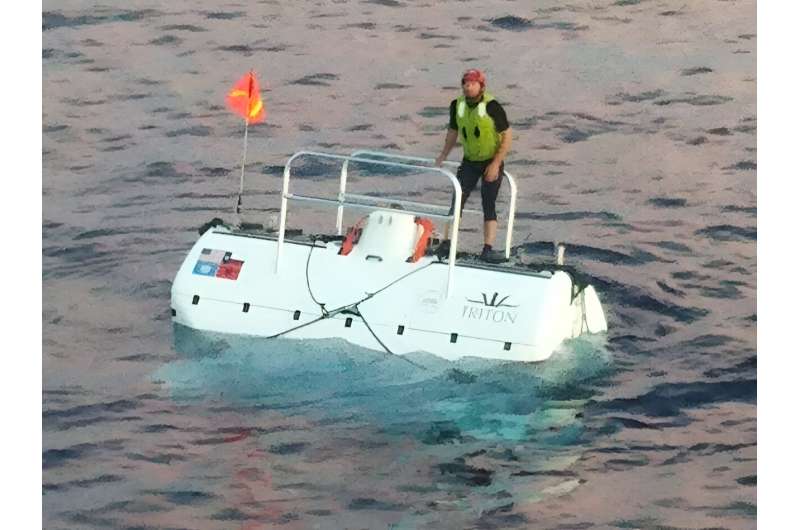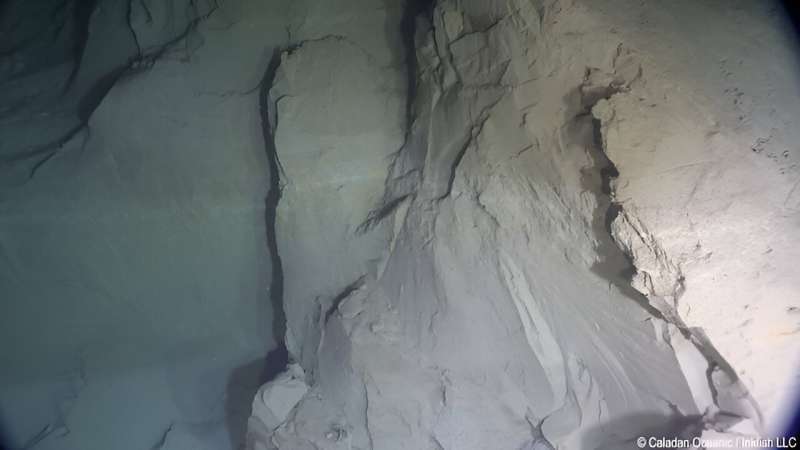Manned submersible finds a fault scarp of the 2011 Tohoku-oki megaquake in the Japan Trench
On September 4, 2022, Hayato Ueda, a geologist at Niigata University, boarded a submarine vehicle with pilot, Chris May, and took a dive into the Japan Trench within the epicenter area of the 2011 Tohoku-oki megaquake, which caused the devastating tsunami disaster.
On the 7,500 m deep trench bottom, they found a 26 m high nearly vertical cliff on the eastern slope of a 60 m high ridge. Previous bathymetric surveys from the sea surface have revealed that the ridge did not exist before, and appeared just after the megaquake, accompanied by a fault on its eastern flank.
He and his colleagues on deck thus concluded that the cliff was a surface expression of a coseismic movement of the fault. The cliff consisted of unconsolidated soft mud. The lower slope than the cliff was occupied by abundant debris of the same soft mud blocks, which obviously supplied from the cliff. The observed sharp fracture surfaces and highly angular edges, both on the cliff and debris blocks, imply a very quick increase of stress that fractured the soft muds before they plastically flowed, and thus support a coseismic origin of the cliff.

The vehicle traversed the ridge across the fault, precisely measuring the topography using acoustic transponder and pressure gauge. The height and uplifted volume of the ridge both suggested a coseismic slip of the fault as large as 80–120 m (the value depends on the assumed dip angle of the underlying fault) in the Japan Trench.
This estimation is greater than the previously estimated fault slip (~65 m) beneath the slope on the west of the trench axis. They attributed the excess fault slip in the trench to local enhancement owing to the uneven top surface of the subducting Pacific plate, which modified the fault geometry and stability.
The 2011 megaquake resulted from the rupture and slip of the plate boundary fault between the northeast Honshu Island of Japan (Okhotsk plate) and the subducting Pacific plate. After the earthquake, many geodetic and geophysical studies proposed that this coseismic fault movement probably propagated to the trench. Because topographic change by near-surface fault movement is one of the major causes of tsunamis, it is important to precisely know what occurred in the deep-sea trench when the trench-type earthquake such as the 2011 event occurred.
However, because of great depths, no submersible vehicles (neither manned nor remotely operated) had been able to access the Japan Trench bottom.
Now published in the journal Communications Earth & Environment, this study is the first to observe, visually record, and precisely measure the topographic change (including fault cliff) in the trench by a single trench-type megaquake event. It verified that the fault slip surely propagated to the surface at the 2011 event, and deduced that the amount of the slip was at least locally as great as 100 m.
These results are expected to contribute to our understanding of the genesis and hazards of tsunamis triggered by trench-type earthquakes.
More information:
Hayato Ueda et al, The submarine fault scarp of the 2011 Tohoku-oki Earthquake in the Japan Trench, Communications Earth & Environment (2023). DOI: 10.1038/s43247-023-01118-4
Provided by
Niigata University
Citation:
Manned submersible finds a fault scarp of the 2011 Tohoku-oki megaquake in the Japan Trench (2024, January 17)
retrieved 17 January 2024
from https://phys.org/news/2024-01-submersible-fault-scarp-tohoku-oki.html
This document is subject to copyright. Apart from any fair dealing for the purpose of private study or research, no
part may be reproduced without the written permission. The content is provided for information purposes only.

On September 4, 2022, Hayato Ueda, a geologist at Niigata University, boarded a submarine vehicle with pilot, Chris May, and took a dive into the Japan Trench within the epicenter area of the 2011 Tohoku-oki megaquake, which caused the devastating tsunami disaster.
On the 7,500 m deep trench bottom, they found a 26 m high nearly vertical cliff on the eastern slope of a 60 m high ridge. Previous bathymetric surveys from the sea surface have revealed that the ridge did not exist before, and appeared just after the megaquake, accompanied by a fault on its eastern flank.
He and his colleagues on deck thus concluded that the cliff was a surface expression of a coseismic movement of the fault. The cliff consisted of unconsolidated soft mud. The lower slope than the cliff was occupied by abundant debris of the same soft mud blocks, which obviously supplied from the cliff. The observed sharp fracture surfaces and highly angular edges, both on the cliff and debris blocks, imply a very quick increase of stress that fractured the soft muds before they plastically flowed, and thus support a coseismic origin of the cliff.

The vehicle traversed the ridge across the fault, precisely measuring the topography using acoustic transponder and pressure gauge. The height and uplifted volume of the ridge both suggested a coseismic slip of the fault as large as 80–120 m (the value depends on the assumed dip angle of the underlying fault) in the Japan Trench.
This estimation is greater than the previously estimated fault slip (~65 m) beneath the slope on the west of the trench axis. They attributed the excess fault slip in the trench to local enhancement owing to the uneven top surface of the subducting Pacific plate, which modified the fault geometry and stability.
The 2011 megaquake resulted from the rupture and slip of the plate boundary fault between the northeast Honshu Island of Japan (Okhotsk plate) and the subducting Pacific plate. After the earthquake, many geodetic and geophysical studies proposed that this coseismic fault movement probably propagated to the trench. Because topographic change by near-surface fault movement is one of the major causes of tsunamis, it is important to precisely know what occurred in the deep-sea trench when the trench-type earthquake such as the 2011 event occurred.
However, because of great depths, no submersible vehicles (neither manned nor remotely operated) had been able to access the Japan Trench bottom.
Now published in the journal Communications Earth & Environment, this study is the first to observe, visually record, and precisely measure the topographic change (including fault cliff) in the trench by a single trench-type megaquake event. It verified that the fault slip surely propagated to the surface at the 2011 event, and deduced that the amount of the slip was at least locally as great as 100 m.
These results are expected to contribute to our understanding of the genesis and hazards of tsunamis triggered by trench-type earthquakes.
More information:
Hayato Ueda et al, The submarine fault scarp of the 2011 Tohoku-oki Earthquake in the Japan Trench, Communications Earth & Environment (2023). DOI: 10.1038/s43247-023-01118-4
Provided by
Niigata University
Citation:
Manned submersible finds a fault scarp of the 2011 Tohoku-oki megaquake in the Japan Trench (2024, January 17)
retrieved 17 January 2024
from https://phys.org/news/2024-01-submersible-fault-scarp-tohoku-oki.html
This document is subject to copyright. Apart from any fair dealing for the purpose of private study or research, no
part may be reproduced without the written permission. The content is provided for information purposes only.
